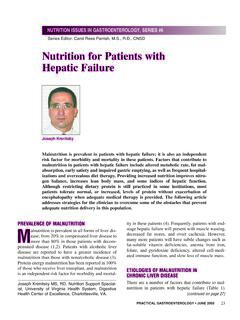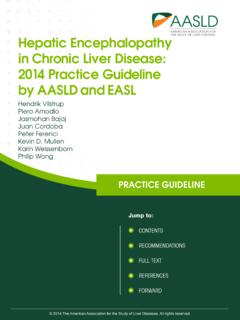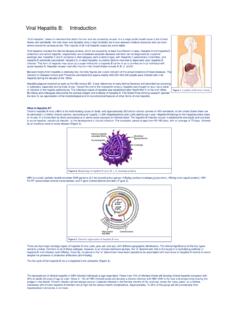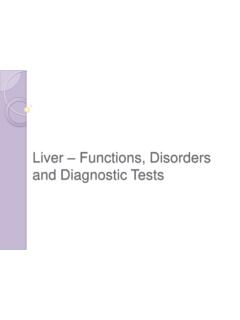Transcription of Guideline on the Evaluation of the Pharmacokinetics of ...
1 European Medicines Agency Evaluation of Medicines for Human Use 7 W estferry Circus, Canary W harf, London, E14 4HB, UK Tel. (44-20) 74 18 84 00 Fax (44-20) 74 18 8613 E-mail: EMEA 2005 Reproduction and/or distribution of this document is authorised for non commercial purposes only provided the EMEA is acknowledged London, 17 February 2005 CPMP/EWP/2339/02 COMMITTEE FOR MEDICINAL PRODUCTS FOR HUMAN USE (CHMP) Guideline ON THE Evaluation OF THE Pharmacokinetics OF MEDICINAL PRODUCTS IN PATIENTS WITH IMPAIRED hepatic FUNCTION. DISCUSSION IN THE EFFICACY WORKING PARTY October 2003 TRANSMISSION TO CHMP February 2004 RELEASE FOR CONSULTATION February 2004 DEADLINE FOR COMMENTS August 2004 DISCUSSION IN THE EFFICACY WORKING PARTY September 2004 January 2005 TRANSMISSION TO CHMP February 2005 ADOPTION BY CHMP February 2005 DATE FOR COMING INTO OPERATION August 2005 CPMP/EW P/2339/02 EMEA 2005 Page 2/10 Guideline ON THE Evaluation OF THE Pharmacokinetics OF MEDICINAL PRODUCTS IN PATIENTS WITH IMPAIRED hepatic FUNCTION 1 INTRODUCTION.
2 3 2 WHEN TO PERFORM PHARMACOKINETIC STUDIES IN PATIENTS WITH IMPAIRED hepatic FUNCTION .. 4 3 STUDY DESIGN .. 4 Classification of hepatic impairment .. 5 Study population .. 6 Drug Administration .. 6 Sample Collection and Analysis .. 7 Population 7 Physiological based pharmacokinetic models .. 7 Pharmacodynamic 7 4 DATA 7 Parameter 8 Presentation of 8 Evaluation of Results and Development of Dosing Recommendations .. 8 5 LABELLING 9 CPMP/EW P/2339/02 EMEA 2005 Page 3/10 This Guideline should be read in conjunction with Directive 2001/83/EC, as amended, and all other pertinent elements outlined in current and future EU and ICH guidelines and regulations especially those on: Pharmacokinetic Studies in Man (Notice to Applicant, Vol.)
3 3C, 3CC3A, 1987) The Investigation of Drug Interactions (CPMP/EWP/560/95) Validation of Analytical Procedures (ICH topic Q2A and Q2B) Structure and Content of Clinical Study Reports (ICH topic E3) Good Clinical Practice (ICH topic E6) General Co nsiderations for Clinical Trials (ICH to pic E8) This Guideline is intended to assist applicants during development of medicinal products. It is only guidance; any deviations from the guidelines should be explained and discussed in the Expert reports/Clinical Overview. 1 INTRODUCTION Pharmacokinetic studies are used to identify special subgroups of patients in whom an alternative dosing regimen may be indicated for efficacy and/or safety reasons. Since liver is an important organ with respect to drug disposition, patients with hepatic impairment constitute an important subgroup of such special populations.
4 hepatic function decreases with age, but due to the high capacity of the liver this is considered not to change the Pharmacokinetics to a clinically relevant extent. liver disease , however, is known to be a common cause of altered Pharmacokinetics of drugs. hepatic function can be decreased through different pathophysiological mechanisms. Worldwide, chronic infections with hepatitis B or C are the most common causes of chronic liver disease , whereas in the western world, chronic and excessive alcohol ingestion is one of the major causes of liver disease . Other causes are uncommon diseases such as primary biliary cirrhosis, primary sclerosing cholangitis and autoimmune chronic active hepatitis. Ongoing destruction of the liver parenchyma in chronic liver diseases ultimately leads to liver cirrhosis and the development of portal hypertension.
5 However, even if liver cirrhosis is established, the residual metabolic function of the liver may be rather well preserved for many years because of regeneration of hepatocytes. Clinical symptoms related to hepato-cellular failure and portal hypertensions are most importantly ascites, oesophageal varices and encephalopathy. Serum markers of liver failure are low serum albumin and a prothrombin deficiency. Serum bilirubin as well as other liver tests may or may not be affected to a varying degree, depending on the liver disease (cholestatic versus hepatocellular). liver cirrhosis is irreversible in nature, but progression can be modified by abstinence of alcohol in alcohol liver cirrhosis. The Pharmacokinetics and pharmacodynamics of drugs may be altered by liver disease through different mechanisms. The effect most often depends on the severity of hepatic impairment.
6 The effects on Pharmacokinetics can be difficult to predict due to consequences of shunting of blood past the liver (both porto-systemic and intra- hepatic ), impaired hepatocellular function, impaired biliary excretion and decreased protein binding. Factors that influence the need for pharmacokinetic data in patients with hepatic impairment, and interpretation of these data, are the intended use of the drug, pharmacokinetic characteristic features in otherwise healthy individuals and PK/PD relationships. Based on this, the major concern (side effects or lack of efficacy) should be identified. CPMP/EW P/2339/02 EMEA 2005 Page 4/10 No obvious marker exists for characterising hepatic function with respect to prediction of drug elimination capacity, in contrast to renal impairment. Therefore, dose recommendations may not be as accurate for hepatic impairment as they can be for renal impairment.
7 Therefore, one of the primary aims of studies in patients with hepatic impairment might be to identify patients at risk. It is the objective of this Guideline to make recommendations regarding: In what situations studies of Pharmacokinetics should be performed in subjects with impaired hepatic function The design of pharmacokinetic studies in subjects with impaired hepatic function Data presentation, analysis, and Evaluation of results Reflectio n o f these results in the SPC in terms of dosing schemes, co ntraindicatio ns, special precautions and warnings for use and description of pharmacokinetic It should be emphasised that due to the complex influence of liver disease on the Pharmacokinetics of drugs and the lack of specific markers, the aim of this Guideline is to stimulate further research rather than to provide specific recommendations.
8 More knowledge is needed within this area and the regulatory requirements must be developed in parallel with the scientific progress. 2 WHEN TO PERFORM PHARMACOKINETIC STUDIES IN PATIENTS WITH IMPAIRED hepatic FUNCTION A pharmacokinetic study in subjects with impaired hepatic function is recommended when: The drug is likely to be used in patients with impaired hepatic function and hepatic impairment is likely to significantly alter the Pharmacokinetics (especially metabo lism and biliary excret ion) of the drug and/or its act ive metabolites and A posology adjustment may be needed for such patients taking into account the PK/PD relatio nship. If no study is performed in patients with hepatic impairment, a justification should be given. Lack of data may be justified if the drug is not intended to be used in patients with hepatic impairment.
9 If the drug is likely to be used in these patients, the applicant should discuss the potential for hepatic impairment to influence the Pharmacokinetics (of parent drug, active and inactive metabolites) and should include relevant information in the SPC (see also section IV). Lack of data may lead to restriction in the use of the drug (not only warnings but also contraindications). 3 STUDY DESIGN The primary goal of a study in patients/subjects with impaired hepatic function is to identify patients at risk in terms of severity of hepatic dysfunction. Depending on the extent to which the pharmacokinetic parameters are affected, the next major objective is to determine the extent to which the dosage should be adjusted to reduce the risk of under or over treatment in these patients. When designing a study, the normal pharmacokinetic properties of the drug should be the starting point.
10 Taking elimination characteristics into account, the sponsor should consider which type(s) of hepatic conditions are likely to affect the Pharmacokinetics and should focus on including subjects with abnormalities in relevant markers. CPMP/EW P/2339/02 EMEA 2005 Page 5/10 Classification of hepatic impairment There are a number of systems that aim to categorise the severity of hepatic impairment. Presently, no well-established, adequate markers for hepatic function in terms of drug elimination capacity are available. The Child-Pugh classification The Child-Pugh classification is the most widely used and is one way of categorising hepatic function. However, it was not developed for the purpose of predicting drug elimination capacity. Using this classification, the subjects are grouped on the basis of two clinical features (encephalopathy and ascites) and three laboratory-based parameters (S-albumin, S-bilirubin and prothrombin time).
















